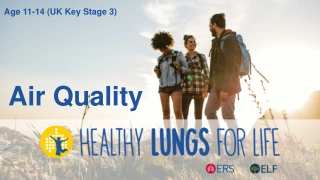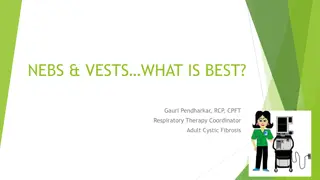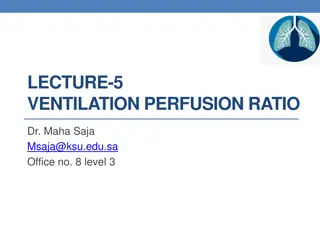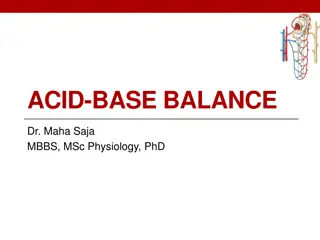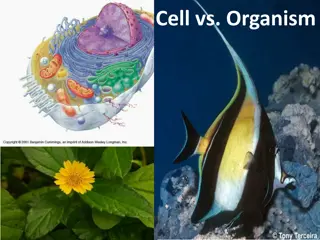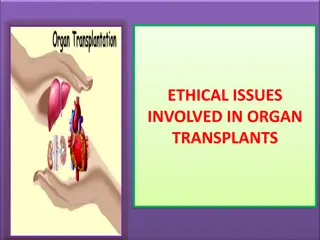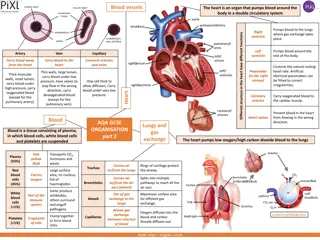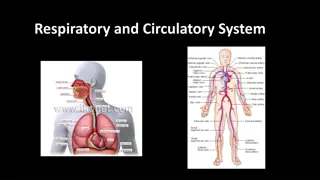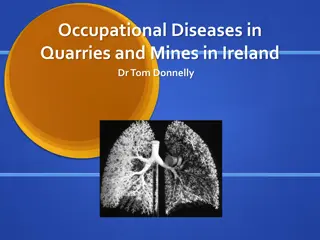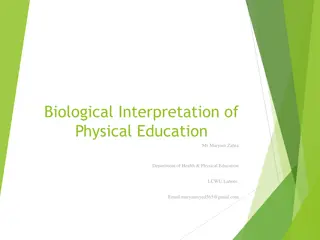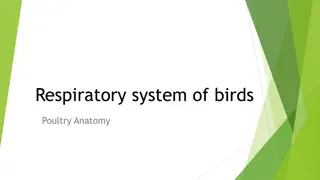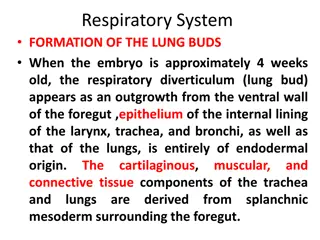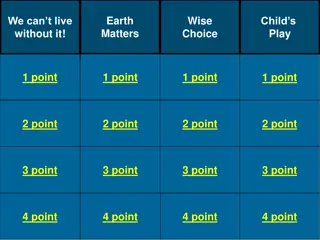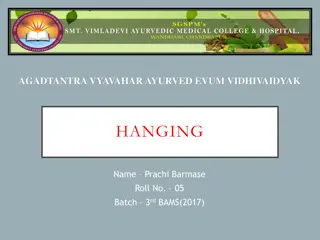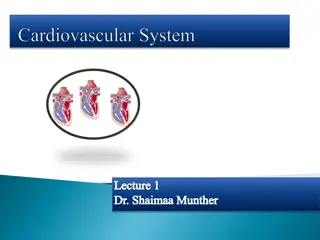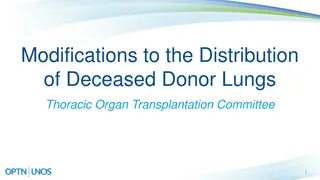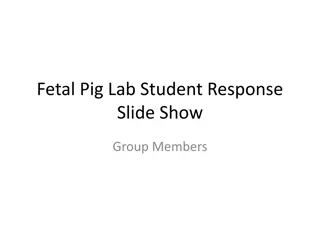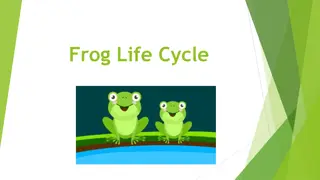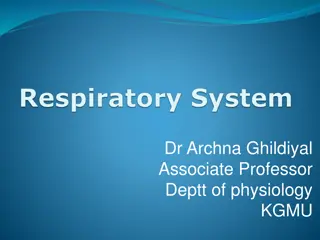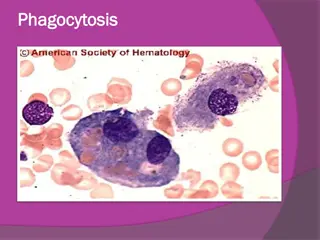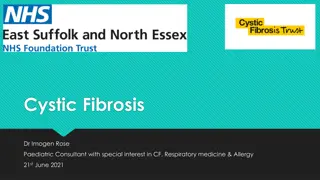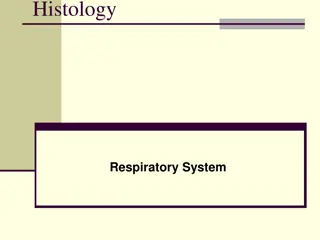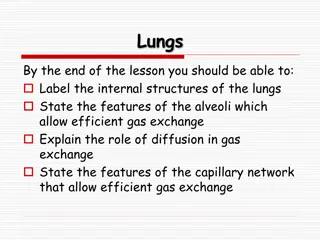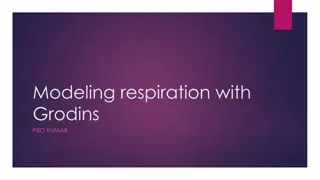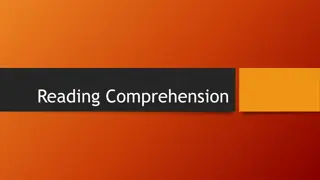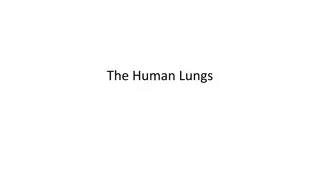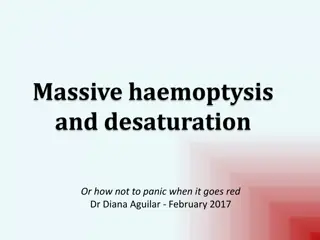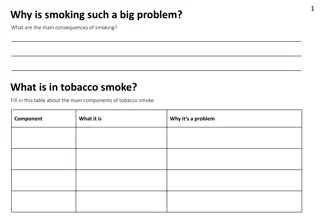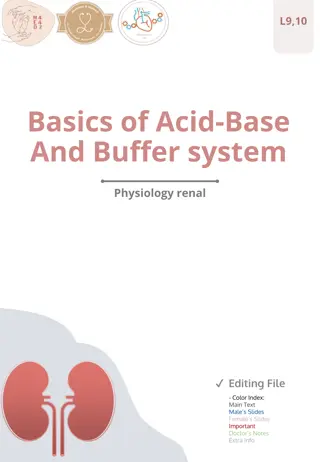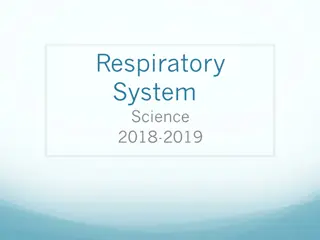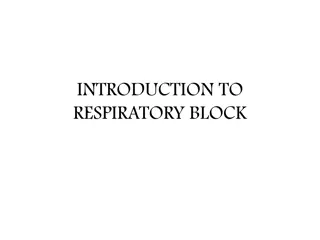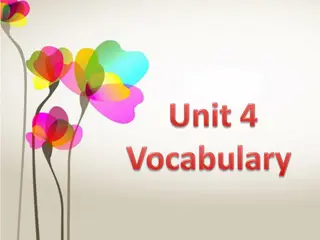Breathe Easy: Understanding Air Pollution and Lung Health
Learn how air pollution affects lungs, worsens asthma, and hinders lung development. Discover the harmful gases and particles in polluted air, causing immediate and long-term issues. Explore asthma and COPD conditions exacerbated by poor air quality.
10 views • 34 slides
Anatomy of the Larynx, Trachea, and Bronchi: Respiratory System Overview
The larynx, trachea, and bronchi are vital structures of the respiratory system with distinct functions and anatomy. The larynx houses vocal cords, aids in breathing, voice production, and swallowing. It is interconnected with major arteries, veins, and nerves in the neck. The trachea extends from t
13 views • 19 slides
Optimizing Respiratory Therapy for Adult Cystic Fibrosis Patients
Creating an effective daily respiratory therapy regimen is crucial for adults with Cystic Fibrosis (CF) to maintain healthy lungs and good lung function. This includes inhaled medications such as nebulizer treatments and bronchodilators, airway clearance techniques like the Vest and Pep devices, as
0 views • 32 slides
Ventilation-Perfusion Ratio in Pulmonary Circulation
This lecture delves into the intricate relationship between ventilation and perfusion in the lungs, highlighting the importance of proper gas exchange for optimal respiratory function. It discusses the circulations supplying the lungs, defines the V/Q ratio, and explores the clinical significance of
0 views • 25 slides
Acid-Base Balance in the Body: Importance and Regulation
Acid-base balance is crucial for maintaining optimal health, as slight deviations in hydrogen ion concentration can impact enzyme activity and metabolic processes. The body employs various defense mechanisms to regulate pH levels, involving buffers, lungs, and kidneys. Strong acids release more H+ i
3 views • 48 slides
Gas Exchange in Cells and Organisms
Gas exchange is vital for cellular respiration and photosynthesis. In organisms, specialized structures like alveoli in lungs and stomata in plants facilitate this process. This exchange occurs through diffusion across moist surfaces with large surface areas. In animals, oxygen is taken up by hemogl
0 views • 40 slides
Ethical Issues in Organ Transplants
Organ transplantation involves the moving of organs from one body to another to replace damaged or absent organs. The process includes cadaveric and living organ donations, with various transplantable organs like lungs, kidneys, heart, and more. There are ethical issues surrounding organ donation de
0 views • 16 slides
Components of the Circulatory System
The circulatory system, comprising the heart, blood vessels, and various components like arteries, veins, and capillaries, plays a crucial role in distributing oxygen, nutrients, and waste products throughout the body. The heart pumps blood through a double circulatory system, ensuring oxygenation o
0 views • 4 slides
The Respiratory System and its Vital Functions
The respiratory system plays a crucial role in our bodies by taking in oxygen and expelling carbon dioxide. Key components include the lungs, diaphragm, bronchi, and alveoli. Air enters through the nose or mouth, travels down the trachea to the lungs, where oxygen is absorbed into the bloodstream an
0 views • 26 slides
Occupational Diseases in Quarries and Mines: Understanding Risks and Prevention
Explore the historical cases and anatomy of lungs in relation to occupational diseases in quarries and mines in Ireland. Learn about crystalline silica, control measures, types of dust, and pneumoconioses to understand the risks and ways to protect respiratory health.
0 views • 21 slides
Benefits of Physical Education: A Biological Perspective
Physical Education (PE) is essential for developing vital skills, knowledge, and attitudes to lead an active and healthy lifestyle, promoting growth, and preventing various health conditions. Regular physical activity strengthens the heart, lungs, and reduces the risk of chronic diseases, emphasizin
0 views • 13 slides
Anatomy of the Respiratory System in Birds: A Detailed Overview
The respiratory system in birds, including poultry, consists of various components such as nostrils, nasal cavities, larynx, trachea, syrinx, air sacs, and lungs. Each part plays a crucial role in respiration, with unique features adapted to avian physiology. Understanding the anatomy of the avian r
3 views • 19 slides
Development of the Respiratory System in Human Embryos
The formation of the lung buds, larynx, trachea, bronchi, and lungs in human embryos involves complex processes where various structures develop from different tissue origins. The lung buds arise from the ventral wall of the foregut, while the larynx, trachea, and bronchi epithelium are of endoderma
7 views • 19 slides
Air Pollution and Respiratory Health
Explore the impact of air pollution on respiratory health, learning about the Air Quality Health Index, importance of green spaces, lungs function, and the role of rain in clearing pollutants. Discover how wind conditions affect air quality and why children and parents need to monitor daily air qual
0 views • 34 slides
COVID-19 Induction Information for Staff & Volunteer Mentors
COVID-19 is an illness caused by the Coronavirus that primarily affects the lungs and airways. It spreads through sneeze or cough droplets and can survive on surfaces. Symptoms may include fever, cough, shortness of breath, loss of smell or taste, and more. If you experience symptoms or have been in
0 views • 14 slides
Utilization of Glands and Biochemicals in Meat Science Research
Glands play a crucial role in meat science research, with various organs such as pancreas, adrenal glands, and parathyroid gland providing valuable biochemicals like insulin, thyroxine, and corticosteroids. The extraction methods and applications of these glands in food science and medicine are deta
0 views • 25 slides
Hanging in Forensic Medicine
Hanging is defined as a violent asphyxial death where air entry to the lungs is blocked by neck constriction due to body suspension. Types include complete and incomplete hanging, with varying degrees of body suspension. Ligatures and signs/symptoms of hanging are discussed, along with treatment mea
0 views • 24 slides
Overview of the Circulatory System and the Heart
The circulatory system comprises the cardiovascular system and the lymphatic system. The heart, a four-chambered double pump, plays a crucial role in pumping blood through the vessels to the lungs and body cells. The heart's structure, function, and components like the atria, ventricles, and valves
0 views • 41 slides
Proposed Modifications to Deceased Donor Lung Distribution
This proposal aims to address issues with the current distribution of deceased donor lungs in thoracic organ transplantation. By removing DSA and implementing a 250 nautical mile circle around the donor hospital, the policy seeks to resolve inconsistencies, complications, and impracticalities in the
0 views • 26 slides
Fetal Pig Dissection Lab: Observing External Features and Respiratory System
In this detailed lab report on fetal pig dissection, students are tasked with observing the external features of the pig, determining its gender, examining teeth and skin, and studying the importance of the umbilical cord. The lab also delves into the respiratory system, focusing on cartilage rings,
0 views • 24 slides
Fascinating Frog Life Cycle Illustrated
Explore the stages of a frog's life cycle through informative word banks and captivating images. From eggs to adult frog, witness the incredible transformations and adaptations in this natural progression. Engage with the journey from tadpole to froglet, observing the development of lungs, hind legs
0 views • 5 slides
A Comparison of Human and Frog Anatomy and Physiology
Humans and frogs share many similarities in their organ systems such as lungs, digestive, circulatory, skeletal, and muscular systems. However, there are also significant differences in body configuration, respiratory system, skeletal structure, and reproductive system. Frogs have unique features li
0 views • 7 slides
Importance of Oral Health and Dental Care Tips
Oral health goes beyond just taking care of your teeth; it involves maintaining your gums, tongue, and overall mouth health. Good oral health not only prevents diseases like cavities and gum disease but also contributes to your confidence, fresh breath, and overall well-being. It plays a vital role
0 views • 27 slides
Mechanics of Pulmonary Ventilation and Respiratory Cycle Explained
Understanding the mechanics of pulmonary ventilation is crucial for comprehending the breathing process. This comprehensive overview covers the role of muscles, ribs, pressure changes in alveolar, pleural, and transpulmonary regions, terms related to breathing and ventilation, and the contraction an
0 views • 31 slides
Phagocytosis, Inflammation, and Granulomas in Tuberculosis
Phagocytosis is a crucial process where cells engulf and digest pathogens. Inflammation responses involve various immune cells like neutrophils, plasma cells, lymphocytes, and macrophages. Granulomas, typical in diseases like tuberculosis, are mass accumulations in chronic inflammation. Tuberculosis
0 views • 18 slides
Cystic Fibrosis: Causes, Symptoms, and Treatment Options
Cystic Fibrosis (CF) is a genetic condition affecting around 11,000 people in the UK. It disrupts salt and water movement in cells, leading to thicker, stickier mucus in the body. This condition can affect the lungs, digestive system, and pancreas, with symptoms such as chronic cough, digestive issu
0 views • 23 slides
Pulmonary Emphysema: Symptoms, Causes, and Pathophysiology
Pulmonary emphysema, a type of obstructive respiratory disorder, is a progressive lung disease that affects the air spaces in the lungs. This condition is primarily caused by long-term exposure to irritants like tobacco smoke and air pollution. The damage to the alveoli leads to symptoms such as sho
0 views • 49 slides
Overview of Mammalian Respiratory System Histology
The respiratory system in mammals functions to warm, humidify, and cleanse the air as it travels from the nostrils to the lungs. It comprises the nasal cavity, pharynx, larynx, trachea, bronchi, and bronchial tree. The epithelial linings vary in different parts, containing specialized cells and glan
0 views • 14 slides
The Anatomy and Function of Lungs
Explore the internal structures of the lungs, the features of alveoli for efficient gas exchange, the role of diffusion in gas exchange, and the characteristics of the capillary network that facilitate efficient gas exchange. Includes visual aids and explanations.
0 views • 9 slides
Grodins Pro Kumar's Model of Respiration
Explore the historical background and compartments of Grodins Pro Kumar's modeling of respiration, from differing breathing rates to the layout and assumptions of lungs, brain, and soft tissue. Learn how the homogeneous system is applied and the methods used to analyze this complex respiratory model
0 views • 18 slides
Innovative Technology for Diagnosing and Managing Respiratory Diseases
Monash University researchers have developed a groundbreaking non-invasive technology to diagnose and manage respiratory lung diseases, such as cystic fibrosis and lung cancer. The technology, utilizing four-dimensional X-ray velocity imaging, provides high-definition real-time images of airflow in
0 views • 4 slides
Pleura and Lung Anatomy
Pleura is a double-layered serous membrane surrounding the lungs, consisting of parietal and visceral layers. The pleural cavity between them contains pleural fluid. Parietal pleura is subdivided into cervical, costal, mediastinal, and diaphragmatic regions. The pleura has nerve supply that makes it
0 views • 31 slides
The Intricate Working of the Human Lungs Explained
The human lungs play a vital role in the efficient exchange of gases to provide oxygen for cellular growth and remove waste gases. Unlike some organisms that can use cutaneous respiration, humans rely on their lungs, which work in harmony with the cardiovascular system. Through a complex process inv
0 views • 11 slides
Managing Massive Haemoptysis and Desaturation: A Comprehensive Guide
This detailed guide covers the fundamentals of massive haemoptysis, including its causes, management options, and complications. It emphasizes the importance of staying calm and following proper protocols to address life-threatening situations effectively. From understanding the blood supply of the
0 views • 20 slides
The Anatomy of Lungs
The lungs, vital organs of the respiratory system, consist of two cone-shaped structures with apex, base, costal, and medial surfaces. Positioned in the thoracic cavity, they are associated with the heart, great vessels, and other structures in the mediastinum. The right lung has three lobes, while
0 views • 16 slides
The Impact of Smoking on Health and Society
Smoking is a significant public health concern due to its harmful effects on the body, particularly the lungs. Tobacco smoke contains various harmful components that contribute to severe health consequences, such as lung cancer, heart disease, and respiratory issues. Passive smoking, or secondhand s
0 views • 7 slides
Acid-Base Balance and Regulation in the Body
Acid-base balance is crucial for maintaining optimal physiological functions. This content explains the definitions of acids and bases, differentiates between strong and weak varieties, explores the significance of pH control in body fluids, and delves into the roles of buffers, kidneys, and lungs i
0 views • 20 slides
The Respiratory System and the Process of Respiration
The respiratory system is vital for breathing as it helps in the exchange of oxygen and carbon dioxide. This system consists of organs such as the lungs, bronchi, and alveoli. The process of respiration involves inhaling air through the nose or mouth, passing it through the trachea and bronchi into
0 views • 5 slides
Comprehensive Overview of Respiratory Block for Medical Students
This respiratory block introduces students to the anatomy, histology, muscles involved in respiration, embryology, radiological anatomy, and management of respiratory disorders. It covers topics like the nasal cavity, pharynx, larynx, trachea, bronchi, lungs, pleura, bronchial tree, and mediastinum.
0 views • 23 slides
Learn About the Body Parts and Common Idioms
Explore the lexical set of body parts including the eyebrow, forehead, lungs, and more. Discover idioms like "get down to business" and "get the better of us" through visual representations. See how expressions like "mark my words" and "get even with him" add richness to everyday language interactio
0 views • 18 slides
